This article features the incredibly kind contributions from true experts in split cane bamboo fly rod building. As well as details of construction and finishing, the interviewees have also revealed personal stories about the magic of a cane rod. So, if you are more interested in the building side of things, you can easily scan down and find those details. At the same time, the stories go some way to explaining the “soul” of a bamboo rod. As a great overview, I found a lovely short film by Rob Hinchcliffe on the Youtube Channel “Trout Fodder” on American builder Don Anderson.
I wanted to contrast my earlier article on “whole cane” lacquered “wazao” rods from Japan with their western split cane counterparts. I know that there are bamboo rod fanatics all around the world from America, England, Italy, Germany, Australia, Switzerland and many more countries – so I really didn’t want to gloss over such an obvious comparison.
First – some writing; and then pictures and notes…Let’s start with a great story from Andrew Griffiths:
Andrew Griffiths: @GlassJet on Twitter (Journalist and Cane Rod Addict)
“Photograph of bamboo”
My favourite photo of my bamboo rod is rubbish. This rod has been photographed a lot, for stories, both by me with a pretty good camera setup, and by real pros too. We’ve all tried to create a ‘portrait’ of the rod, if a portrait is something that reveals an inner character. But we haven’t really. We’ve tried to create a public face, make it into an object of desire, a lifestyle, cast a light on it that makes it look like that brandy-glow character we’ve now generally accepted to be the caricature of bamboo fishing. These pictures are fine as far as they go, but they lack those messy, frozen moments of quiet intimacy.
Which is why my own favourite isn’t one of these. It is one taken on a riverbank (it happens to be my favourite river, but no one would ever guess that from the picture) and it is high summer. It is a tangle of brambles, grasses, and most probably Himalayan balsam too because it is taking over my favourite stream. There are some branches sticking out. And there’s an old log too, if I remember rightly. I can’t remember exactly how many branches there are – two? Three? It doesn’t matter. But what does matter is that one of those branches is my bamboo rod.
The photo isn’t sharp. It is poor resolution by today’s standards, but then it is an old camera, a fujifilm Z20, lime green, a clam design, bought in that colour because it was the same as the one the woman had who I was seeing at the time and there’s another memory right there. She had two children, girls, one was on my knee, three years old, on the office type chair in the living room and as she lurched forwards, her curly hair bouncing, that laugh and that smile and breakfast still smeared over her face she reached out and a still clumsy finger stabbed on the computer screen on the webstore and it landed on one in lime green just like hers and so I looked at her mother and she shrugged her shoulders and laughed with her daughter, both of them together and so lime green it was going to be for me too.
Another reason the picture is hazy is because that old camera has been dropped in the river a few times now. It just happens. Three times it has happened. If that had been my phone it would have been my life gone, which is why I take out this old camera when I am fishing. But each time I’ve dried it out and it just seems to keep on working. After that last there is a permanent blur on the image, a cataract, but I have grown to like the scar, live with it, and it seems apt somehow so I don’t care.
But that rod is the most exquisite piece of craftsmanship of anything that I own. It was built by Richard Holden (featured below, Ed.), who confusingly makes rods under the name John French – there is a story about why that is but I don’t recall it right now. It is six feet six inches long, and a three weight. It has been flamed, so it has that a dark, roast coffee lustre to it. I am probably not supposed to say this, but it is built like a Thomas & Thomas ‘Caenis’ action, which means that it is surprisingly ‘tippy’ for a cane rod.
Put a silk line on it, and it is one of the most beautiful casting instruments I have ever used, and I’ve cast a fair selection of high end carbon now, too. It is perfect for the small, spate rivers that I fish.
That tip is so fine it is hard to credit six pieces of planed wood have gone into its making. But its delicacy is a charade. I’ve had some good fish on this rod. The best was a 20 inch wild brown trout that took a dry on my home River Goyt. It was plain good luck that the night before I had read how to handle a big fish on a cane rod on Luke Bannister’s website: hold the rod high and at a low angle so the strain is spread over the length, rather than concentrated at its tip.
I am over six feet tall and I was holding this rod as high as I could as that brownie chugged away round the river on the end of a 6X leader. I just remember half of me being shocked that something this kind of size had taken hold of my fly, and half of me looking up in amazement as that ‘tippy’ rod was suddenly bending right down to the butt, up against the trees and the sky on that summer’s evening I watched that gentle curve of cane arc right down to the cork and the tight muscles of my straining arm.
I wasn’t the only person watching either. On the footpath just behind me half a dozen dog walkers formed a Greek chorus of ‘Oohs’ and ‘Ahhs’. When I finally scooped up that fish in the net there was a cheer, and the words: ‘I can’t believe a rod like that caught a fish that size’ were said. And neither could I. Cliches get that way for a reason. It could have gone bigger too, it had power to spare.
Once the fish had gone the rod became the centre of attention. But as polite conversation was made I just wanted them to go and leave me with the pounding memory of that fish, my hands still wet from its handling.
The rod had done what it had been built to do and it now was done. It had caught a fish and built a memory and now it was ready to meld back into its surroundings. As I walked home against the trickle of evening dog walkers, one of their dogs, a collie, snapped at its lead and lunged and tried to take hold of the rod as I passed but I lifted it out of the way in time and the dog’s owner and me we laughed. I said no worries and told her that when I was casting, dogs round here often thought I was going to throw a stick for them, so I was ready for it.
She looked and smiled and it was just an old stick in my hand, something that could have been pulled from the hedge. I walked home happy. It was something unremarkable, and of my own again.
Ends
Andrew writes for many angling and news publications around the world – and you should follow him on Twitter @GlassJet
Bamboo Fly Rod Components and Finishes: Adam Rawson, Rawson & Perrin
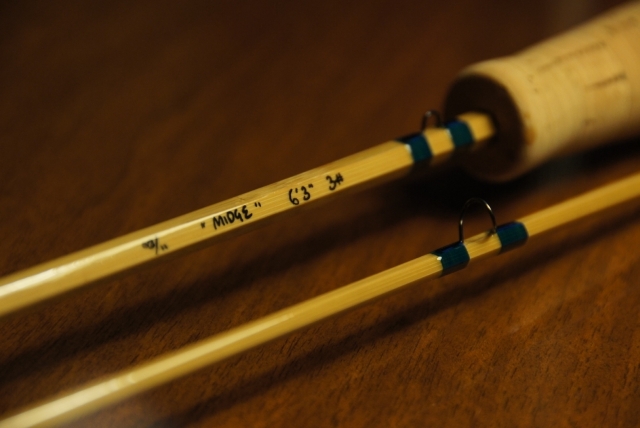
With the exception of our blonde rods, all our bamboo is flamed as a whole cane culm. After culm selection, the flaming process is the first step in the creation of our rods. The cane is flamed from the middle to the ends, which drives the moisture out of the culm which is vital in achieving a ‘steely’ actioned rod. The more you flame the culm, the darker the cane becomes – this allows for some creativity if, for example, you flame some parts more than others, a striped blank can be made. Blonde rods require tempering in an oven in order to maintain the lighter colour of the natural bamboo whilst still getting rid of any remaining moisture in the cane. Many classic rods were made this way, which along with many other factors led to their slower actions (in comparisons to modern cane rods).
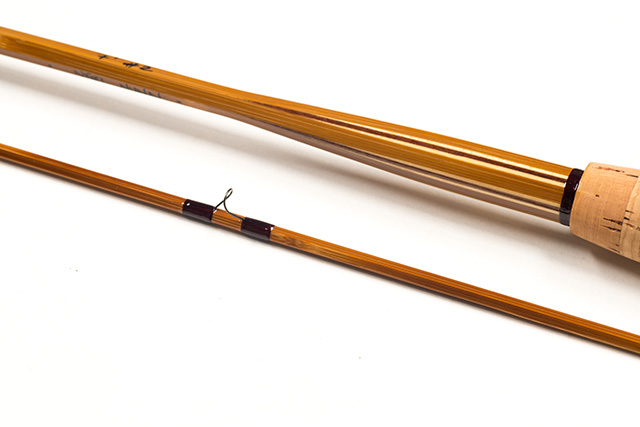
Once planed and glued, there are many different way to finish the completed blank. Applying varnish, oil and impregnating the cane are the most common ways to keep moisture out of the rod. There are also different ways of applying each of these finishes which can be as simple or as complicated as you want it to be.
Varnish
In terms of varnish, most builders I know use one of the many yacht varnishes that are available. These tend to be a tung oil based finish and they give a durable, weatherproof and high gloss sheen. This, of course can be rubbed down afterwards to give a satin or matt appearance if needed.
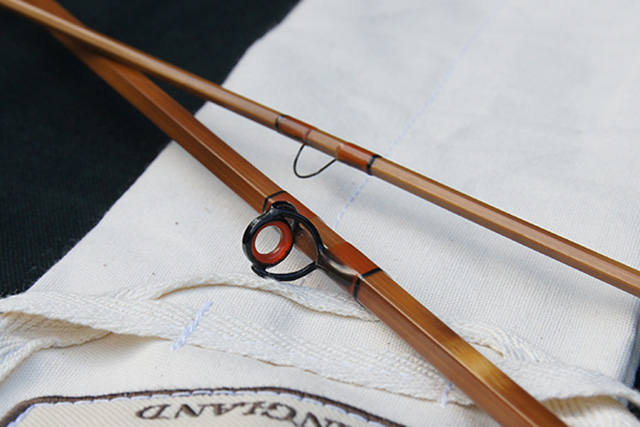
Oil
As mentioned above, tung oil is often used in a varnish mix, however hand rubbed pure tung oil is also a finishing option. Arguably, it requires a lot more work to get a nice finish, particularly if the guides are whipped on prior to blank finishing. Similarly, hand rubbed danish oil and gunstock oil will give a pleasing finish.
Impregnating
This
is the method of soaking the rod in a chemical mix to ‘seal’ all the
fibres in the bamboo, effectively making it water resistant. Once cured,
the blank is sanded and polished to give a range of finishes from satin
to glossy.
There are also different ways of applying each of these
finishes which can be as simple or as complicated as you want it to be.
From simply wiping or brushing the finish on, to using elaborate
‘dipping motor rigs’ which extrude the blank from a tube of varnish at a
set rate to achieve the best possible finish. Whatever the chosen
finish, it almost always comes down to the same thing to achieve the
best finish – applying several thin coats that are lightly sanded before the next goes on.
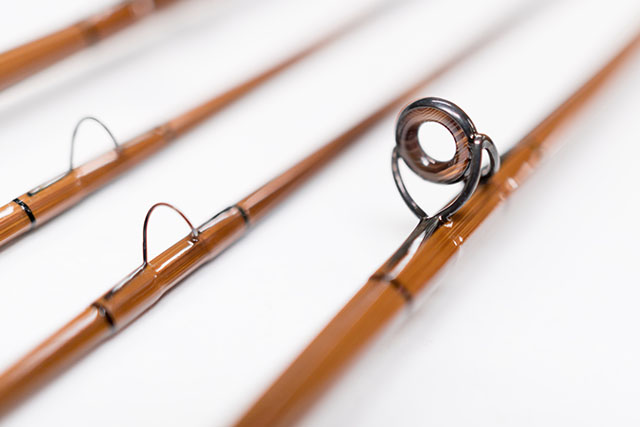
The fixtures or hardware options that can be used on the finished blank are almost endless. We make almost everything ourselves, which adds even more options, but we try to make decisions based on what is best for the rod, rather than doing something for the sake of doing it.
Reelseats
Things to consider are whether it is uplocking or downlocking, is a fighting butt needed, what kind of wood to use, is wood the best option, would a cork insert balance the rod better? Whilst minor, these decisions will affect how the rod feels in the operator’s hand.
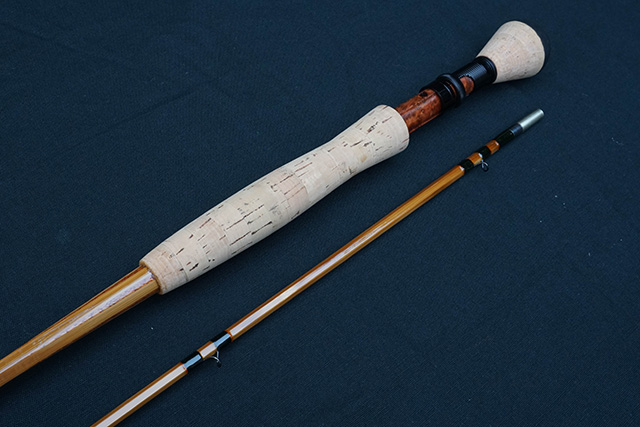
Ferrules
The most common material these days is nickel silver which is not only hard wearing but can be easily blued if needed to match reelseat fittings and guide choices. Other options are brass which is more readily available and easier to machine. Another option that we use is bamboo. The 3 main benefits of a bamboo ferrule are that it allows the rod sections to be lined up with ease, it doesn’t stop the action of the rod as much as metal ferrule (which in certain rods is beneficial) and that it will keep the weight of the rod down.
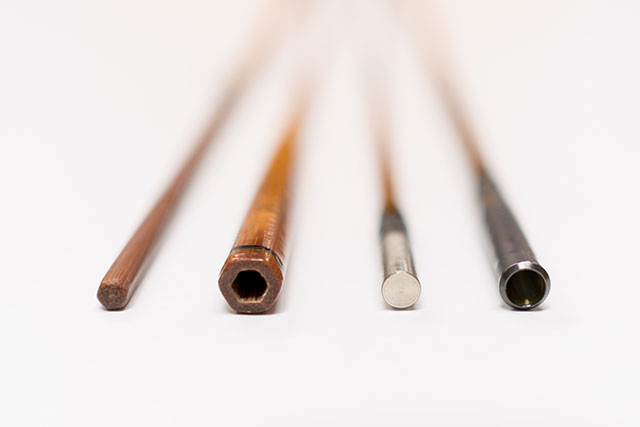
The final option here is to have no ferrules, either by using shorter one piece rods or by splicing sections together with tape – this option gives the same benefits as the bamboo ferrule.
Guides
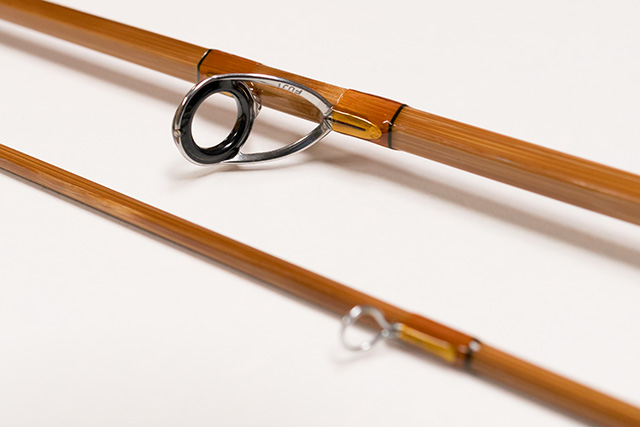
Whilst most guides will do the same job, each rod builder and angler will have their favourites. For fly rods, we prefer a traditional style snake or single leg standoff guide which are made from hard chrome and if required, coated to give them a darker appearance. The butt ring or stripper guide is almost always a traditional style agate which can be sourced in various colours but we like to match them to the whipping colours.
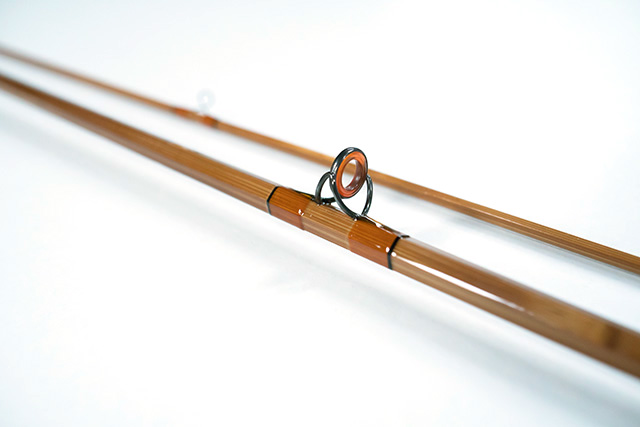
Guide finishing
As with the finishing of the blank there are many options here. We use fine silk threads and varnish that impregnates the silk to prevent cracking in years to come. This results in pleasing translucent colours and when built up with numerous thin coats, a nice even finish that doesn’t lose the hexagonal shape of the cane blank.
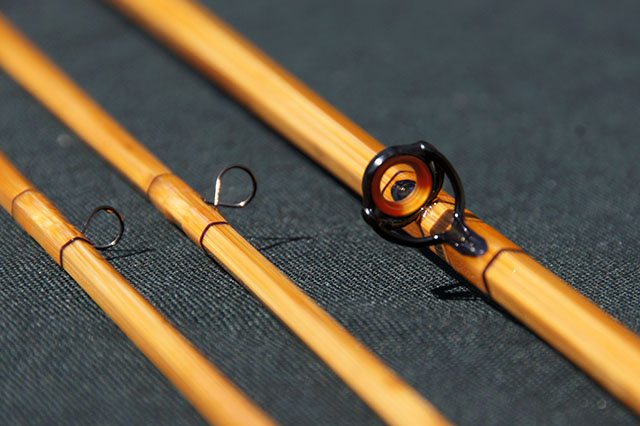
If, as with carbon or glass rods, epoxy was used and then placed on a rod turner to dry you would lose this hexagonal shape and simply have round ‘blobs’ – something we do not like on our rods. In years gone by, colour preserver would be applied to the silk or nylon thread before the varnish. This stopped the varnish impregnating the thread and whilst this preserves the original colour of the thread, it also increases the risk of the finish cracking in years to come.
A Perfect Bamboo fly rod fish capture?
I’ve found it an impossible task to describe my perfect fish capture, narrowing it down to one species or one location is too hard for someone who enjoys standing in a buffeting coastal wind throwing flies at bass or mullet as much as a warm evening on a small stream watching trout ignore my flies… However, all scenarios that went through my mind included the following ingredients:
Quiet
The first thing I think of is being away from the masses, the hustle and bustle and standing somewhere where the only noises are made by nature around me.
Moving water
Be it sea, river or stream moving water gives me the biggest buzz. The constantly changing environment in these places offers the biggest reward for me.
Sight fishing
The thrill of seeing the fish you’re attempting to catch before it sees you, creeping into a position to make a cast and then watching it react to your fly is immensely rewarding.
Dawn or dusk
Regardless of the venue, but perhaps dependant on the targeted species dawn or dusk for me offers the best feast for the senses. Everything seems more alive.
Frustration before elation
Thinking back, all of my favourite fishing memories include frustration before elation – casting every fly in your box over a fish only for it to remain unmoved, going home tying a different fly, returning the next day and finally fooling the fish gives a sense of accomplishment. One of the last trout I caught came from a spot under a tree that I have attempted to catch for years. The tricky cast makes it almost impossible and you only get one chance to make the perfect cast before the fish bolts upstream. Once I finally landed the modest sized trout I was elated. A sense of having to work for/overcome something in order to catch the target fish is a must for me, regardless of fish size.
The fight
A spirited hard fighting fish that hoops over your cane rod, keeps you on your toes, heads for every snag and until the last minute never gives you the feeling that you’re in total control is the final ingredient in my perfect fish capture recipe.
The release
Watching the fish swim away is as pleasing for me as all of the above. Leaving as small a footprint on these special and increasingly rare places as you can is an important responsibility that each angler has.
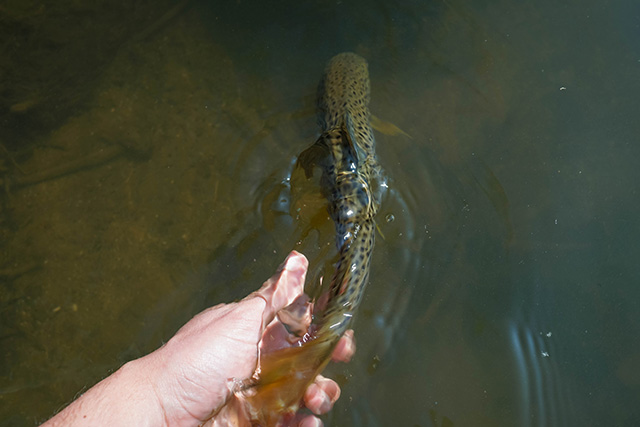
The First Split Cane Rod I owned…
Although I’d waggled a few cane rods before, the first cane rod I actually owned and used was a Sharpe’s of Aberdeen Scottie rod that I bought off eBay for perhaps £12. It was a 9’ #5 and I think the first fish I caught on it was actually a chub, not big, perhaps a pound but I still remember being able to feel every thump of its head as it tried to shake free. I’d bought it just to try. To see what it felt like, to catch a fish and feel it. I was also a keen coarse angler and enjoyed watching and reading Chris Yates films and books so I’ve probably got him to thank for making me curious about cane.
Peter Arfield (AAPGAI Professional Instructor): BAKEWELL FLY FISHING SHOP, 3a HEBDEN COURT, BAKEWELL, DERBYSHIRE. TEL : 01629 813531
Casting and Fishing a Bamboo Fly Rod
Casting with a split cane and adapting to it is a subject worth more than a little study because of the range of actions we can find in the rods, and the very real situation that many anglers have their own idiosyncratic style with carbon or with cane.
Modern Bamboo Fly Rods
In general, a modern taper will perform the same cast with much the same result as with a carbon but with a touch less acceleration on the back cast and on the forward cast and a less abrupt “stop” on both. Can we take a tiny bit longer pause on the backstroke to let the power build as a given/ The upshot is we can cast with less effort.. this for the shorter modern rods.
Antique Bamboo Rods
A heavier “vintage rod can be slow or fast, but most elderly rods of around nine or ten feet long can be an abomination to cast. A reel with some heft to it is a big help and the old adage let the rod do the work proves its worth. Some anglers advocate a long side stroke, so that the butt of the rod points towards the target and a gentle pull through and relaxing the grip at the stroke end kills much of any untoward vibrations on the rod and therefore the line. using a silk line or a modern equivalent , is a big help, the smaller ring sets tend to favour slim lines in any case.
Marrying a Split Cane Rod with a Silk Fly Line
Make no mistake about performance though .A modern silk line on a modern tapered split cane rod of up to around eight feet or so is a fish catching tool which many carbon makers have been striving to emulate for a good while now. One or two have have come close but a good rod has that thing we call soul, and will speak to the angler like little else does.
Playing Fish on a Bamboo Rod
Playing a fish is like on a carbon, but better.. we should of course take care to keep the tip at a low angle and not to rear vertically and back, Tenkara style, I like to turn the rod upside down and reach back as i draw the this to the net. If the fish makes a plunge then I can yield two arms lengths without undue stress.
With a heavy fish, turning the rod to equalise any stress can help straighten the rod, but oddly a slightly skewed rod tip seems not to affect the accuracy of the cast, although it should. It is said that a rod takes on the character of the owner, and there is some truth in this. It is just possible that a good cane rod will tire a fish more rapidly than carbon, Maybe the saying that an angler can feel the heart beats more readily, but that may be the anglers heart, in fairness.
Verdict on Modern Versus Antique Split Cane Rods
There is a big difference casting and fishing a vintage rod to a modern one, The modern tapers and build make the modern rod a superior beast in just about every regard, we treasure the Old rods for what they were, and what they are now. a recognition of the debt we owe to the builders of yesteryear.
Peter, through his shop in Bakewell, is the point of contact for people who buy “John French” cane rods mentioned in Andrew Griffiths’ story. These are completely hand-planed by their maker Richard Holman.
Richard Holman – Completely Hand-planed “John French” Bamboo Rods
John French Split Cane Rods
Our aim is to provide a range of high quality varnished split bamboo fly rods to match the requirements of today’s fly fishermen. It is our belief that Bamboo is still the only material from which it is possible to build a truly unique rod. This is because cane rods can be individually built combining choices from an infinite variety of tapers, lengths, actions and designs which have been developed over 150 years.
These rods are not factory produced for a mass market; each rod is unique and is the result of a month’s hard work (by hand) and over thirty years of experience. Up to around 8’, and 5 weight lines bamboo rods really come into their own. They are accurate, a pleasure to cast, present flies beautifully and have excellent line mending abilities.
In addition to this, bamboo has a exquisite natural colour and appearance which makes owning a cane rod part of the wider richness of our sport. The old- fashioned heavy and “noodly” cane rod is, thankfully, no longer with us. A lot of effort and expertise has gone into the design of the tapers of the modern bamboo rod. All of our rods are intended for stream and river fishing for trout and grayling – typically using dry flies and small nymphs. Since the 1980’s they have been tried and tested on many different streams around the country and have earned positive testimonials from many experienced fly fisherman. Peter uses them for his AAPGAI River Techniques casting demonstrations at fishing fairs and puts them through their paces on the famous limestone rivers of Derbyshire and Staffordshire, home of the dry fly technique. They have earned their pedigree.
They will cover usual fishing distances of 50 feet and weigh in between 2 and 4 oz.
Although there are a lot of technical aspects to bamboo rod design, we like to describe the different “characters” that our rods have to help fishermen select the right one for them. For the fly fisherman who is new to bamboo fly rods but would like to own one, it might be helpful to think in terms of three basic actions when thinking of how to choose a rod to suit your particular needs and fishing style:
Inclined tip action
A rod with a relatively stiff butt, with the action or movement mostly concentrated in the upper sections of the rod. This action is particularly suited to close range upstream dry fly fishing.
These rods may be considered as “fast” with fine tips which throw a narrow loop; they provide maximum line control, a high back cast and precision at short distances. For this reason they can be a good choice for the less experienced fisherman. However, they need skilled hands to cast long distances without overloading their fine tips.
KEY WORDS: FAST, CRISP, PRECISE, CONTROL. HIGH BACK CAST
Medium “progressive” action
These rods load progressively. This means that the rod bends progressively furtherdown into the butt as the rod is “loaded” with longer line when the cast is lengthened. They are characterised by a smooth, relaxed feel. The action protects fine leaders on the strike and gives good control and respectable distance on the cast. They are more forgiving of casting errors. and provide greater latitude when it comes to choice of line size, usually working well with at a least a line size either side of the rated line. These rods are ideal for dry fly or nymphs and require less precise timing than either the fast, tip-actioned or semi-parabolic rod. They make excellent all-round rods which become much-loved fishing companions.
KEY WORDS: SMOOTH, FRIENDLY, EASY, FORGIVING, RELIABLE,
ADAPTABLE, RESILIENT
Semi-parabolic action
This design allows the lower third of the rod to engage quickly to impart power where longer casts are required; the centre third acts as a lever and the top third has a medium fast tip which transmits force to turn over the cast. This tip section also facilitates casting close in with nice tight loops. The top 8 -10 inches have quite an abrupt taper to protect small flies and tippets and to ensure safe hooking. It requires a slightly different timing to get its optimum performance, but once mastered it will cast a long line. This design is also a good choice where roll-casting is often needed. A rod for the more experienced river fisherman.
KEY WORDS: STRONG, ROLL-CAST, LONG LINE, DELAYED TIMING
If you are interested in trying a cane rod, please contact: PETER ARFIELD, BAKEWELL FLY FISHING SHOP (address and phone number above)
Favourite Bamboo Rod?
Favourite rod is difficult, but I have a personal liking for a modified Garrison 202e 7’ 2 piece for a 4-5 line – modified to include a swelled butt section which stops the action length just above the grip and has the effect of speeding up the action a little – one of two other small dimension changes along the length. Here are the diameter settings (in thousandths of an inch at each distance, in inches, along the sections – from the “tip-wards” end to the “butt-wards” end. This is the essential recipe for a cane rod and tells the maker how to set up the formers to allow each section to be planed accurately. Ed.):
BUTT
0 : 178
5 : 190
10: 204
15 : 218
20 : 230
25 : 242
30 : 254
33 : 360
42 : 360
TIP
0 : 062
5 : 078
10 : 098
15 : 118
20 : 128
25 : 140
30 : 150
35 : 162
40 : 172
42 : 178
This produces a very smooth, almost perfect stream rod in my opinion. Other favourites :
A favourite of everyone I’ve made one for is the Paul Young Midge. Paul Young Perfectionist is a great taper – variations on this taper very popular in Japan I understand. A lovely 3 piece 7’ rod from my mentor Marcus Warwick. The Limestone I make for Peter’s shop is proving to be very popular. FE Thomas 6’ 8” 3 weight FE Thomas 7’ 6” 4 weight 3 piece 7’ 6” 3 weight I’ve made for myself recently – my own design.
What Makes a Good Cane Rod?
A good bamboo rod should feel light in the hand when balanced with correct reel and line. It should not tire the fisherman if used all day. It should be responsive, without excessive tip vibration. It should be able to consistently deliver a straight and accurate line. It should be able to turn over a short line and leader when fishing in close but then be able to extend a longer line without too much false casting. It should be able lift a reasonable line from the water and return it without collapsing and should enable the angler to mend line on the water. It should respond to varying casting speeds and throw a tight loop when required. It should contain enough power within its taper to handle a good fish when necessary.
A great rod becomes an extension of the angler’s arm and enables him to place his fly where he wants without thinking.
Pitfalls for Rod Builders
I am not sure what mistakes are common to new builders – there are so many that we all make when we begin. However, the main mistake that I made was to try and rush through to the final planing stage too quickly. It is a big mistake for anyone who, like me, uses the hand planing method.
I have found over the years that more time spent on the initial preparation of strips – straightening and node work – always pays dividends in the long run. Strips sit much more happily in the planing forms if they are well prepared. Everything afterwards – angles and fit – depends on starting with straight and flat strips.
This lesson was first brought home to me when I spent an evening with Richard “Dickie” James, ex-rodmaker for Walker Bampton, Hardy’s and Farlows. Although it was years ago, I have not forgotten watching him prepare strips in his workshop in Shilbottle, Northumberland. He worked his rods entirely by hand and was, I think, the last exponent of the original Alnwick method of rod building.
He spent so much more time than I did at his bench “fettling” each individual strip before taking it forward for planing to final dimensions and that was a lesson I took home with me to Rutland. My work improved no end as a result. Strip preparation is repetitive and somewhat boring compared to other stages of rod making, but it warrants the extra time and attention.
This may seem a little obscure but anybody who has had a go at hand planing will know what I am talking about.
Richard Holman can be contacted – and his work experienced – through Peter Arfield at the Bakewell Fly Fishing Shop.
Article Updates
As with many of these in-depth articles, I will continue to add to them over time – so do check back and keep an eye out for updates. For instance, right now Edward Barder is drafting a detailed account of the tools and processes involved in producing the famous Barder Cane Rods from his wonderful workshop in the historic mill at the confluence of Lambourn and Kennet in Berkshire.
I’m personally really looking forward to those additions (including photos), so I’ll be sure to share them with you as soon as I can.
Paul
PS Do help to spread the cool things about our favourite pastime using the Whizzy Social Share buttons on this page.
